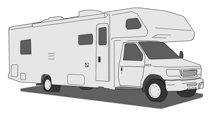Often, even parents who normally are careful to use a CR for their children for every ride imagine that the interior of a recreational vehicle (RV, or motor home) is somehow a magical zone where the laws of physics do not apply. Caregivers need to know that an RV may not be safe for children.
Children still need to be buckled up appropriately any time they are riding in a vehicle, and this can be a real challenge in an RV. RVs come in a range of style classes (A, B, C, C+, etc.) and, although these do vary in appropriateness for families, none is ideal.
People reason that bigger vehicles tend to withstand crash forces better, and this may lull some RVers into a false sense of security. However, bigger isn’t actually safer when it comes to RVs. Unlike school buses, which must meet the strict structural standards of several FMVSSs, RVs are not subject to school bus standards, nor do many of the crashworthiness standards governing cars apply. Because of this and design features that may include seams in the sides for things like galley slide-outs, an RV’s size may not translate to superior structural soundness.
In addition, although seat belts are sometimes present in the living areas, the anchorages for these are not required to comply with FMVSS 208. In some cases, the belts are just anchored to a piece of board! Also, LATCH anchors are not required.
Parents also must know that CRs should never be installed on rearward- or side-facing vehicle seats, further limiting options. And the problem of loose objects causing injury can be a greater concern aboard a traveling motel room. Even “built-in” cabinets have been known to come loose due to the force of a crash.
Consider these safety tips if considering traveling in an RV with children:
- Anytime you’re on the road, be sure that children always ride properly in a child safety seat.
- Check in the cab of an RV for seating positions that are appropriate for car seat installation. Unlike Class As, smaller Class B and C RVs are built on a regular van/truck chassis. These types must meet the same safety standards as passenger vehicles, and therefore are more likely to have the features needed for car seat use.
- Since a car seat is more likely to fit safely in a regular passenger vehicle, consider using one to tow a trailer rather than using an RV.
- If you plan to tow a car behind an RV for local jaunts, consider driving this vehicle instead, with children properly buckled up inside.
- Make a rule that all occupants stay buckled up properly inside an RV anytime it is moving.
Resource: RV Consumer Group

